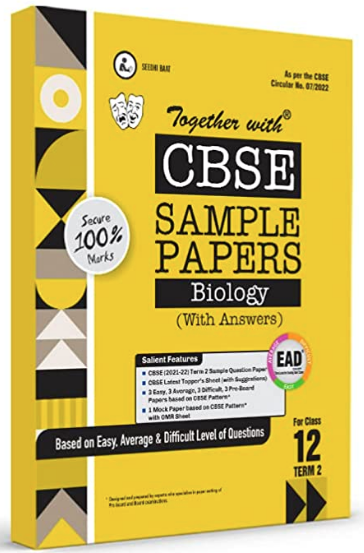1 Humans have innate immunity for protection against pathogens that may enter the gut along with food. What are the two barriers that protect the body from such pathogens?
Answer.
Microbial pathogens enter the gut of humans along with food:
Physical barriers: Mucus coating of the epithelium lining the
gastrointestinal tract helps in trapping microbes entering our body.
Physiological barriers: Acid in the stomach, saliva in the mouth
prevent microbial growth.
2 A patient admitted in ICU was diagnosed to have suffered from myocardial infarction. The condition of coronary artery is depicted in the image below. Name two bioactive agents and their mode of action that can improve this condition
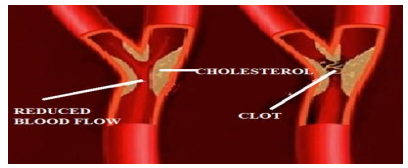
OR
Substantiate by giving two reasons as to why a holistic understanding of the flora and fauna the cropland is required before introducing an appropriate biocontrol method.
Answer.
Streptokinase (produced by the bacterium Streptococcus) is used as a ‘clot buster’ for removing clots from the blood vessels of patients who have undergone myocardial infarction. Statins (produced by the yeast Monascus purpureus) act as bloodcholesterol lowering agents.
OR
Eradication of pests will disrupt predator-prey relationships, where
beneficial predatory and parasitic insects which depend upon flora and fauna as food or hosts, may not be able to survive. Holistic approach ensures that various life forms that inhabit the field,
their life cycles, patterns of feeding and the habitats that they prefer
are extensively studied and considered.
3 Identify the compound chemical structure is shown below. State any three of its physical properties.
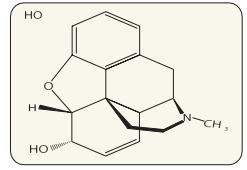
Answer.
It is Morphine. Physically it appears as a white, odourless, crystalline compound.
4 Water samples were collected at points A, B and C in a segment of a river near a sugar factory and tested for BOD level. The BOD levels of samples A, B and C were 400 mg/L, 480 mg/L and 8 mg/L respectively.
What is this indicative of? Explain why the BOD level gets reduced considerably at the collection point C?
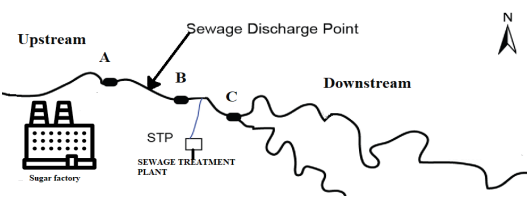
Answer.
At collection points A and B, the BOD level is high due to high organic pollution caused by sugar factory and sewage discharge.
At the collection point C, the water was released after secondary
treatment/ biological treatment (where vigorous growth of useful
aerobic microbes into flocs consume the major part of the organic
matter present in the river water or effluent due to sugar factory and
sewage discharge).
5 An ecologist study an area with population A, thriving on unlimited resources and showing exponential growth, introduced population B and C to the same area. What will be the effect on the growth pattern of the population A, B and C when living together in the same habitat?
Answer.
This interaction will lead to competition between the individuals of
population A,B and C for resources. Eventually the ‘fittest’ individuals
will survive and reproduce. The resources for growth will become finite and limiting, and population growth will become realistic.
6 With the decline in the population of fig species it was noticed that the population of wasp species also started to decline. What is the relationship between the two and what could be the possible reason for decline of wasps?
OR
With the increase in the global temperature, the inhabitants of Antarctica are facing fluctuations in the temperature. Out of the regulators and the conformers, which of the two will have better chances of survival?
Give two adaptations that support them to survive in the ambient environment? Give one suitable example.
Answer.
The relationship between the plant and pollinator is called mutualism.
Fig depends on wasp for pollination, and wasp depends on fig for
food and shelter. With the decline in population of figs, wasp loses its source of food and shelter.
OR
Regulators; Thermoregulation, Osmoregulation Birds/mammals
7 How do normal cells get transformed into cancerous neoplastic cells? Elaborate giving three examples of inducing agent.
OR
A person is suffering from a high-grade fever. Which symptoms will help to identify if he/she is suffering from Typhoid, Pneumonia or Malaria?
Answer.
Transformation of normal cells into cancerous neoplastic cells may beinduced by following physical, chemical or biological agents causing
DNA damage:
● Ionising radiations like X-rays and gamma rays
● Non-ionizing radiations like UV.
● Chemical carcinogens present in tobacco smoke
● Cellular oncogenes (c-onc) or proto-oncogenes, when
activated under certain conditions cause cancer. Viruses with
oncogenes can transform normal cells to cancerous cells.
OR
If the person has sustained high fever (39° to 40°C), weakness,
stomach pain, constipation, headache and loss of appetite, it is
Typhoid. If the person has fever, chills, cough and headache; and the lips and fingernails turn gray to bluish, it is Pneumonia.
If the person has chills and high fever recurring every three to four
days then, it is Malaria.
8 Recognition of an antigenic protein of a pathogen or exposure to a pathogen occurs during many types of immune responses, including active immunity and induced active immunity. Specify the types of responses elicited when human beings get encountered by a pathogen.
Answer.
● When our body encounters an antigenic protein or a pathogen for
the first time it produces a response which is of low intensity and
our body retains memory of the first encounter.
● The subsequent encounter with the same pathogen elicits a
highly intensified response carried out with the help of two special types of lymphocytes present in our blood, B3
3
lymphocytes, and T-lymphocytes.
● The B-lymphocytes produce an army of proteins in response to
these pathogens into our blood to fight with them. These proteins
are called antibodies. The T-cells themselves do not secrete antibodies but help B-cells produce them.
9 In a pathological lab, a series of steps were undertaken for finding the gene of interest. Describe the steps, or make a flow chart showing the process of amplification of this gene of interest.
Answer.
The flow chart shows the three steps involved in the process of PCR
showing the following
– Denaturation The DNA strands are treated with a temperature of
940C (Heat) and the strands are separated.
– Annealing The primers anneal to the complementary strands
– Extension The DNA polymerase facilitates the extension of the
strands.
OR
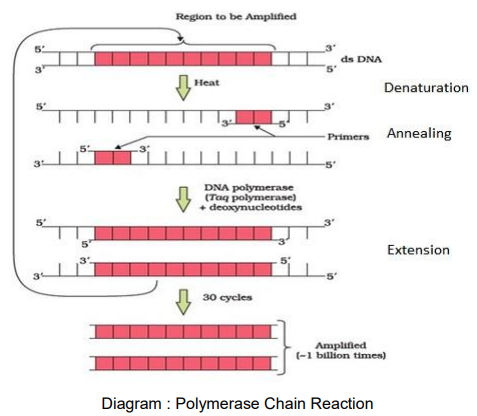
10 a. ‘The Evil Quartet’ describes the rates of species extinction due to human activities. Explain how the population of organisms is affected by fragmentation the habitats.
b. Introduction of alien species has led to environmental damage and decline of indigenous species. Give any one example of how it has affected the indigenous species?
c. Could the extinction of Steller’s sea cow and passenger pigeon be saved by man? Give reasons to support your answer.
Answer.
a. When a large habitat is broken into small fragments due to various
activities, mammals and birds requiring large territories and certain
animals with migratory habitats are badly affected, leading to
population decline.
b.
● Nile perch introduced in Lake Victoria eventually led to the
extinction of an ecologically unique assemblage of more than
200 species of cichild fish.
● Parthenium/Lantana/water hyacinth caused environmental
damage and threat to our native species
● African catfish-Clarias gariepinus introduced for aquaculture
purposes is posing a threat to the indigenous catfishes in our
rivers. (Any one)
c. Yes; Humans have overexploited natural resources for their ‘greed’
rather than ‘need’ leading to extinction of these animals.
Sustainable harvesting could have prevented extinction of these
species.
11 a. The image shown below is of a sacred grove found in India. Explain how has human involvement helped in the preservation of these biodiversity rich regions.

b. Value of Z (regression coefficient) is considered for measuring the species richness of an area. If the value of Z is 0.7 for area A ,and 0.15 for area B, which area has higher species richness and a steeper slope?
Answer.
a. India’s history of religious and cultural traditions emphasized the
protection of nature. In many cultures, tracts of forest are set
aside, all the trees and wildlife within are venerated and given total
protection. Sacred groves in many states are the last refuges for a
large number of rare and threatened plants.
b. Area A will have more species richness and a steeper slope.
12 The image below depicts the result of gel electrophoresis
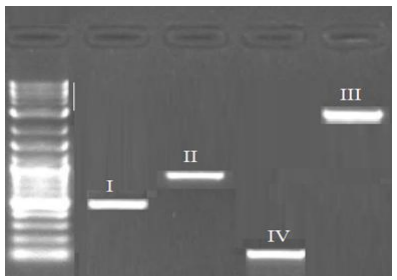
If the ladder represents sequence length upto 3000 base pairs (bp),
a. Which of the bands (I – IV) correspond to 2500 bp and 100 bp respectively?
b. Explain the basis of this kind of separation and also mention the significance of this process.
Answer.
a. Band III corresponds to 2500 base pairs, and Band IV corresponds to 100bp.
b. The fragments will resolve according to their size. The shorter
sequence fragments would move farthest from well as seen in
Band IV (100 bp) which is lighter as compared to Band III which is
heavier being 2500 base pairs. The significance of electrophoresis is to purify the DNA fragments for use in constructing recombinant DNA by joining them with
cloning vectors.
13 Some restriction enzymes break a phosphodiester bond on both the DNA strands, such that only one end of each molecule is cut and these ends
have regions of single stranded DNA. BamH1is one such restriction enzyme which binds at the recognition sequence, 5’-GGATCC- 3’and cleaves these sequences just after the 5’- guanine on each strand.
a. What is the objective of this action?
b. Explain how the gene of interest is introduced into a vector.
c. You are given the DNA shown below.
5’ ATTTTGAGGATCCGTAATGTCCT 3’
3’ TAAAACTCCTAGGCATTACAGGA 5’
If this DNA was cut with BamHI, how many DNA fragments would you expect? Write the sequence of these double-stranded DNA fragments with their respective polarity.
d. A gene M was introduced into E.coli cloning vector PBR322 at BamH1 site. What will be its impact on the recombinant plamids? Give a possible way by which you could differentiate non recombinant to recombinant plasmids.
OR
GM crops especially Bt crops are known to have higher resistance to pest attacks. To substantiate this an experimental study was conducted in different farmlands growing Bt and non Bt-Cotton crops. The farm lands had the same dimensions, fertility and were under similar climatic conditions. The histogram below shows the usage of pesticides on Bt crops and non-Bt crops in these farm lands.
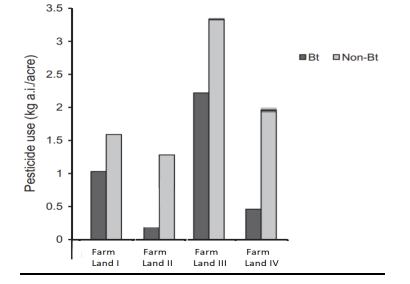
a. Which of the above 4 farm lands has successfully applied the concepts of Biotechnology to show better management practices and use of agrochemicals? If you had to cultivate, which crop would you prefer (Bt
or Non- Bt) and why?
b. Cotton Bollworms were introduced in another experimental study on the above farm lands wherein no pesticide was used. Explain what effect would a Bt and Non Bt crop have on the pest
Answer.
a. The two different DNA molecules will have compatible ends to
recombine. (½ mark)
b. Restriction enzyme cuts the DNA of the vector and then ligates the
gene of interest into the DNA of the vector.
c. 2 fragments (½ mark)
5’ ATTTTGAG 3’5’GATCCGTAATGTCCT 3’
3’ TAAAACTCCTAG 5’.3’GCATTACAGGA 5’
d. BamH1 site will affect tetracycline antibiotic resistance gene,
hence the recombinant plasmids will lose tetracycline resistance
due to inactivation of the resistance gene.
Recombinants can be selected from non recombinants by plating
into a medium containing tetracycline, as the recombinants will not
grow in the medium because the tetracycline resistance gene is
cut.
OR

